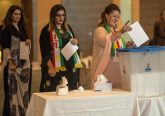The South Korean legislative election on 15 April 2020 received high attention in international news as the first national election held under the constraints of the COVID-19 pandemic. Still, voter turnout, at 66.2 per cent, was the highest in 28 years and a North Korean defector, for the first time, was elected to the unicameral National Assembly (Gukhoe). The election, which resulted in a landslide victory for the incumbent government’s party, was the first under a new electoral reform that introduced compensation seats within the proportional representation (PR) tier of the mixed electoral system. In response, both major parties set up satellite organisations that only competed for PR seats. Thereby, the major parties consolidated their hegemony in the National Assembly and frustrated the attempt to provide smaller parties with chances to gain additional seats. This has shown again the weakness of the Korean party system, which remains chaotic and highly volatile.
The Republic of Korea transitioned to democracy in the late 1980s and has since become a free and stable liberal democracy. However, the Korean party system has low institutionalisation— the parties frequently change their names, split, and merge with one another. Despite the lack of stable party organisations, steady interparty competition has emerged along programmatic lines. The contenders can be roughly described as a conservative platform (currently named United Future Party, UFP) with a regional support centre in the South-East (Yeongnam) and a centre-left platform (Democratic Party, DP), traditionally strong in the South-West (Honam). Strong regionalism in Korea has prevented the system from becoming a pure two-party system, yet the systemic ‘Duvergian’ pressure to lower the number of serious competitors in districts remains. Both platforms take different positions on salient issues such as North Korean relations, social policy, or the economy. As Korean parties are volatile entities, the number of effective parties varies in each election.
The reform, passed in December 2019, sought to change the way seats are distributed in the election of the Korean National Assembly to make the election system fairer for smaller parties. The legislature has 300 seats that are distributed through a mixed electoral system using two ballots. 253 of the seats are allocated through plurality votes in single-member constituencies. The remaining 47 seats are awarded by proportional list votes. While the single-member constituencies favoured, in accordance with Duverger’s Law, a two-party system, the PR seats gave smaller parties a better chance to win seats. The old system can be best described as a mixed-member majoritarian system (MMM): the majoritarian first-past-the-post element and the proportional vote ran parallel to each other, without one component affecting the other.
The changes to the electoral law were a careful attempt at shifting to a mixed-member proportional vote (MMP), long demanded by smaller parties, who were disadvantaged by the election system. For example, the People’s Party came second in the 2016 election’s PR tier (ahead of the DP) with 6.3 million votes (26.7 per cent), but received only 13 PR seats and won 25 districts. The overall victorious DP lacked a majority in the National Assembly, so it depended on the votes of smaller parties who demanded changes to the electoral system. Yet compared to earlier proposals, the reform fell flat. The number of PR seats was kept stable and only 30 of the 47 PR seats are distributed to compensate parties who received few or no seats through the plurality vote compared to their proportional share. Given the dominance of the two parties in the competition for district votes, third parties would have gained many of these compensatory seats. The reform also lowered the voting age from 19 to 18.
Alas, the conservative UFP, which opposed the reform, came up with an innovation to take advantage of it: a satellite party, eventually named the Future Korea Party (FKP). After initially protesting, the DP followed suit and established the Together Citizens’ Party. The main parties (DP and UFP) competed in the single-member districts and refrained from running for the proportional vote. Their smaller satellites (Together Citizens’ and FKP), on the other hand, only compete as party lists but not for districts. The respective blocks’ party brandings are near identical to provide cues to voters. An earlier attempt for the FKP to mirror the UFP’s name (then named Liberty Korea Party) and add the word ‘proportional’ to it, was thwarted by the National Election Commission.
The satellite parties scooped up 36 of the 47 PR seats that otherwise would have gone to smaller, independent competitors. It is expected that lawmakers from the satellite parties will rejoin their colleagues from the main parties in their parliamentary caucuses. The winners of the election, DP and Together Citizen’s Party, will hold 180 of the 300 seats in the National Assembly. Smaller third parties did poorly in this election. The strongest, the progressive Justice Party, gained 2.7 million PR votes (9.67 per cent), yet received only five PR seats (and won one district). Arguably, the weak organisational basis of Korean parties and their low stability and durability made it easier to set up satellite parties that contravened the recent electoral reform without creating much public upheaval about capturing the election. South Korean democracy remains strong, but this is despite the political parties, not because of them.






1 Comment